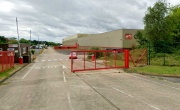Construction waste: ‘Out of site’, out of mind?
With plastics waste hogging the headlines, Allan Sandilands, Senior Consultant at Resource Futures, shines a light on construction waste – the ‘silent sector’ that has slipped under the radar at a time of heightened focus on waste and resources
I cannot recall a time when waste was in the headlines more frequently than now, not just within industry publications, but also in the mainstream media. It appears that finally the message is getting through. However, whilst the public outrage at coffee cups, cotton buds, straws and wet wipes is rightfully gaining momentum, our single largest waste producing industry remains silent.

The construction industry accounted for over five million tonnes of waste in 2016 in Scotland, which is nearly 50 per cent of Scotland’s waste! So, that being said, why isn’t there a public outcry? Is it a case of ‘out of site’, out of mind?
Well, maybe it’s because David Attenborough has yet to highlight any sea mammals who have been killed due to ingesting plasterboard or being crushed under a tonne of soil and stones. I say this flippantly; however, the relative contribution of this waste-producing sector is not being widely acknowledged.
In truth, there are numerous reasons why there has been such little movement in the waste volumes produced by the sector, beyond the peaks and troughs of construction output, but I have chosen the three main ones to tackle in this piece.
Lack of ‘stick’
The carrot vs stick argument is an eternal dilemma for government, as both are needed to effect change. However, in this case the carrot has been available to the construction sector in the form of free support for years.
The lack of stick is evident in the meagre size of punishments dished out by the Scottish Environment Protection Agency (SEPA) for non-compliance, the lack of waste segregation that should be driven by the Waste (Scotland) Regulations and stagnating waste disposal costs. These all result in a lack of impetus to change behaviours.
Perhaps the forthcoming landfill ban in Scotland for biodegradable municipal waste by 2021, which will likely have a significant impact on pricing and availability of services, could lead to a change in behaviour.
Lack of procurement drive
‘Sustainable procurement’ is at times a statement that, if spoken too loudly, can disappear like mist on a lake and at other times can be seen as a core foundation of an organisation’s approach. The inconsistent application of sustainable procurement clauses on projects makes it near impossible to achieve mainstream change.
Sustainable procurement clauses, especially in the public sector, are the most powerful tool available to drive consistent measurement, increased prevention and good practice in waste management on projects. However, the lack of these types of requirements in contracts highlights that this is not being uniformly applied.
Construction project clients have historically dodged their responsibility for waste by claiming that it is a contractor issue and have failed to both drive improved waste project performance and to recognise their basic responsibilities under the Duty of Care regulations.
Industry culture
The ‘it’s not my waste’ culture still exists within the supply chains operating on construction sites. As most large contractors typically provide the skips on large to medium-sized projects, this leads to the supply chain subcontractors having no responsibility for the waste disposal and they therefore lack the incentive to prevent waste from being created.
Many large contractors will say they are working with their supply chain to educate and enforce correct practices, however they will be the first to admit that it is difficult to implement penalties or incentives.
On smaller construction projects, the mixed waste skip is king. With claims of lack of space and lack of sufficient volume to justify segregation, this part of the sector seems unlikely to change without significant intervention and regulation. So recyclable construction waste all too often ends up going straight to landfill.
Bringing the ‘silent sector’ to the table
The bottom line is: waste produced on construction sites is viewed as an acceptable, unavoidable outcome. What is needed to shift this view?
Many things have been tried in the last decade, from sector Voluntary Agreements, such as the WRAP ‘Halving Waste to Landfill’ campaign, to Site Waste Management Plans (voluntary in Scotland) to try and combat this persistent problem. Surplus material sharing platforms are popping up all the time and there are a wealth of free tools and guidance already available.
In Scotland, Zero Waste Scotland’s (ZWS) Resource Efficient Scotland Programme is currently offering free support to all small and medium-sized enterprises (SMEs) in the construction and demolition sector. This support is being funded through the European Regional Development Fund (ERDF).
Lessons have been learned from those who have taken up free support; however, change from top to bottom has yet to be fully embedded.
It is for these reasons that I think now is the time for the Scottish Government to mandate a long-term strategy for waste reduction in the sector starting with an industry waste reduction target.
The Scottish Food and Drink Industry is proof that sector targets can be effective in motivating more organisations and sector bodies to take action and implement change. The target of a 33 per cent reduction in food waste by 2025 is considered to be a challenging but achievable one for the sector and has helped galvanise action.
Now, some people will say: but there already is a sector target, so why do we need a new one? A construction waste recovery target of 70 per cent by 2020 exists across the whole of the UK, but this target focuses on recovery, not prevention. Despite the construction sector consistently exceeding this recovery target since 2011 (with recycling rates above 90 per cent every year) this is not driving the change we really need to see, which is a reduction in the total waste produced and much greater reuse of materials.
Hence the need for a new, smart waste prevention target: one which will challenge the sector to transform and innovate, to explore new circular economy products and packaging solutions and to encourage design and build with deconstruction in mind from the outset. And above all, one which will raise the profile of this huge problem and encourage the ‘silent sector’ to come to the table.








